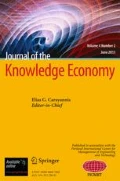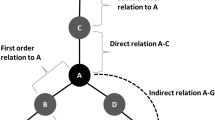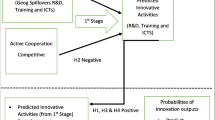Abstract
This article investigates the relation between recombinative capabilities, innovation and alliance strategies for 71 firms in the Information Communication Technologies (ICT) sector, through a panel data analysis. In particular, it explores the impact of two factors on innovation. The first is the recombinative capabilities of firms, which are measured by the breadth of their patents. The second is their alliance strategies, which are measured in terms of technological proximity with partners. The results reveal that recombinative capabilities increase innovative output. However, there is a limit to this positive effect. Beyond this limit, recombinative capabilities reduce innovation intensity. In other words, after a threshold, the wider is the breadth of the firm’s patents, the less is the number of them. This relationship also depends on the technological proximity with alliance partners. High recombinative capabilities are best complemented by technologically proximate alliance partners, who permit refinements in existing domains, without augmenting costs of variety management.

Similar content being viewed by others
Notes
We collect also the technological fields of the firms (that are not necessarily included in our sample) involved in a strategic alliance with the firm in our sample.
The mapping between IPC codes and 30 technology fields is based on the study by Fraunhofer Gessellschaft-ISI (Karlsrube), Institut National de la Propriété Industrielle (INPI-Paris) and Observatoire des Sciences et des Techniques (OST, Paris).
As there are some missing variables in the measure of R&D expenditure, the sample is reduced to 245 observations.
According to Estimation (2), \( \frac{\partial P}{\partial TechProx}=1.67-2.9\; TechProx+3.98\; recomb \)
References
Ahuja, G., & Katila, R. (2001). Technological acquisitions and the innovation performance of acquiring firms: a longitudinal study. Strategic Management Journal, 22, 197–220.
Antonelli, C. (2006). The business governance of localized knowledge: an information economics approach for the economics of knowledge. Industry and Innovation, 13(3), 227–261.
Antonelli, C., Krafft, J., & Quatrato, F. (2010). Recombinant knowledge and growth: the case of ICTs. Structural Change and Economic Dynamics, 21, 50–69.
Arora, A., & Gambardella, A. (1994). Evaluating technological information and utilizing it. Journal of Economic Behavior and Organization, 24(1), 91–114.
Arthur, B. (2009). The nature of technology. New York: Free Press.
Banbury, G., & Mitchell, W. (1995). The effect of introducing important incremental innovations on market share and business survival. Strategic Management Journal, 16(special issue), 161–182.
Bassala, G. (1988). The evolution of technology. New York: Cambridge University Press.
Blau, P. (1977). Heterogeneity and inequality. New York: Free Press.
Breschi, S., Lissoni, F., & Malerba, F. (2003). Knowledge relatedness in firm technological diversification. Research Policy, 32, 69–87.
Bresnahan, T. F., & Malerba, F. (1999). Industrial dynamics and the evolution of Firms’ and Nations’ competitive capabilities in the world computer industry. In: D. C. Mowery, & R. R. Nelson (Eds.), Sources of industrial leadership (pp. 79-132).
Cameron, C., & Trivedi, P. (2009). Microeconometrics using Stata. College Station, Texas: Stata.
Carnabuci, G., & Bruggeman, J. (2009). Knowledge specialization, knowledge brokerage and the uneven growth of technology domains. Social Forces, 88(2), 607–641.
Cassiman, B., & Veugelers, R. (2006). In search of complementarity in the innovation strategy: internal R&D and external knowledge acquisition. Management Science, 52, 68–82.
Cecere, G. (2009). VoIP diffusion among new entrants: a path dependent process. Industry and Innovation, 16(2), 219–245.
Cohen, W., & Levinthal, D. (1990). Absorptive capacity: a new perspective on learning and innovation. Administrative Science Quarterly, 35, 128–152.
Corrocher, N., Malerba, F., & Montobbio, F. (2007). Schumpeterian patterns of innovative activity in the ICT field. Research Policy, 36, 418–432.
Cowan, R., & Jonard, N. (2009). Knowledge portfolios and the organization of innovation networks. Academy of Management Review, 34, 320–342.
Duysters, G., & Lokshin, B. (2011). Determinants of alliance portfolio complexity and its effect on innovative performance of companies. Journal of Product Innovation Management, 28(4), 570–585.
Dyer, J. H., & Nobeoka, K. (2000). Creating and managing a high-performance knowledge-sharing network: the toyota case. Strategic Management 21(3), p345, 23.
Fleming, L. (2002). Finding the organizational sources of technological breakthroughs: the story of Hewlett-Packard’s thermal ink-jet. Industrial and Corporate Change, 11(5), 1059–1084.
Fleming, L., & Marx, M. (2006). Managing creativity in a small world. California Management Review, 48, 6–27.
Galunic, D. C., & Rodan, S. (1998). Resource recombinations in the firm. Strategic Management Journal, 19(12), 1193–1201.
Garcia-Vega, M. (2006). Does technological diversification promote innovation?: an empirical analysis for European firms. Research Policy, 35(2), 230–246.
Gilfillan, S. (1935). Inventing the ship. Chicago: Follett Publishing Co.
Gilsing, V., Nooteboom, B., Vanhaverbeke, W., Duysters, G., & van de Oord, A. (2008). Network embeddedness and the exploration of novel technologies: technological distance, between centrality and density. Research Policy, 37, 1717–1731.
Gronbach, L. (1987). Statistical tests for moderator variables: flaws in analyses recently proposed. Psychological Bulletin, 102, 414–417.
Hausman, J., Hall, B., & Griliches, Z. (1984). Econometric models for count data with an application to the patents—R&D relationship. Econometrica, 52, 909–938.
Helfat, C. E. (1994). Evolutionary trajectories in petroleum firm R&D. Management Science, 40(12), 1720–1747.
Jiang, R., Tao, Q., & Santoro, M. (2010). Alliance portfolio diversity and firm performance. Strategic Management Journal, 31(10), 1136–1144.
Kogut, B., & Zander, U. (1992). Knowledge of the firm, combinative capabilities and replication of new technology. Organization Science, 33, 383–397.
Lavie, D., & Miller, S. R. (2008). Alliance portfolio internationalization and firm performance organization. Science, 19(4), 623–646.
Lavie, D., & Rosenkopf, L. (2006). Balancing exploration and exploitation in alliance formation. Academy of Management Journal, 49(4), 797–818.
Lavie, D., Stettner, U., & Tushman, M. (2010). Exploration and exploitation within and across organizations. Academy of Management Annals, 4, 109–155.
Lavie, D., Kang, J., & Rosenkopf, L. (2011). Balance within and across domains: the performance implications of exploration and exploitation in alliances. Organization Science, 22(6), 1517–1538.
Leonard-Barton, D. (1992). Core capabilities and core rigidities a paradox in managing new product development. Strategic Management Journal, 13, 111–125.
Lin, Z., Yang, H., & Arya, B. (2010). Alliance partners and firm performance: resource complementarity and status association. Strategic Management Journal, 30(9), 921–940.
March, J. (1991). Exploration and exploitation in organizational learning, organization. Science, 2, 71–87.
Miller, D. J., Fern, M. J., & Cardinal, L. B. (2007). The use of knowledge for technological innovation within diversified firms. Academy of Management Journal, 50(2), 308–326.
Mowery, D. C., & Rosenberg, N. (1989). Technology and the pursuit of economic growth. New York: Cambridge University Press.
Mowery, D. C., Oxley, J. E., & Silverman, B. S. (1998). Technological overlap and interfirm coordination: implications for the resource-based view of the firm. Research Policy, 27, 507–523.
Nahapiet, J., & Ghoshal, S. (1997). Social capital, intellectual capital and the creation of value in firms. Academy of Management Proceedings, 97, 35–39.
Nelson, R., & Winter, S. (1982). An evolutionary theory of economic change. Cambridge: Harvard University Press.
Nooteboom, B., Vanhaverbeke, W., Duysters, G. M., Gilsing, V. A., & van den Oord, A. (2007). Optimal cognitive distance and absorptive capacity. Research Policy, 367, 1016–1034.
Powell, W. W., Koput, K., & Smith-Doerr, L. (1996). Interorganizational learning and the locus of innovation networks of learning in biotechnology. Administrative Science Quarterly, 41, 116–145.
Rao, P. M., Vemuri, V. K., & Galvin, P. (2004) The changing technological profile of the leading ICT firms: evidence from US patent data, 1981-2000. Industry & Innovation, 11(4), 353–372.
Schilling, M. A. (2008). Understanding the alliance data. Strategic Management Journal, 30(3), 233–260.
Schmoch, U. (2008). Concept of a technology classification for country comparisons, Final Report.
Schoenmakers, W., & Duysters, G. (2006). Learning in strategic technology alliances. Technology Analysis and Strategic Management, 18, 245–264.
Schoenmakers, W., & Duysters, G. (2010). The technological origins of radical inventions. Research Policy, 39(8), 1051–1059.
Schumpeter, J. A. (1934). Theorie der wirtschaftlichen Entwicklung. Leipzig: Duncker & Humblot. English translation published in 1934 as The theory of economic development. Cambridge, MA: Harvard University Press.
Srivastava, M. K., & Gnyawali, D. R. (2011). When do relational resources matter? Leveraging portfolio technological resources for breakthrough innovation. The Academy of Management Journal, 54(4), 797–810.
Steinmuller, E. (2007). The economics of ICTs Building blocks and implications. In R. Mansell, C. Avgerou, & D. Quah (Eds.), The Oxford handbook of information and communication technologies. Oxford: Oxford University Press.
Stuart, T. E., & Podolny, M. (1996). Local search and the evolution of technological capabilities. Strategic Management Journal, 17(special issue), 21–38.
van den Bergh, J. C. J. M. (2008). Optimal diversity increasing returns versus recombinant innovation. Journal of Economic Behaviour and Organization, 68(3–4), 565–580.
Van den Ende, J., & Dolfsma, W. (2005). Technology-push, demand-pull and the shaping of the technological paradigms: patterns in the development of computing technology. Journal of Evolutionary Economic, 15, 83–99.
Vanhaverbeke, W., Gilsing, V., Beerkens, B., & Duysters, G. (2009). The role of alliance network redundancy in the creation of core and non-core technologies. Journal of Management Studies, 46(2), 215–244.
Vincenti, W. (1990). What engineers know and how they know it. Baltimore: John Hopkins University Press.
Weitzman, M. L. (1998). Recombinant growth. Quarterly Journal of Economics, 113, 331–360.
Yamakawa, Y., Yang, H., & Lin, Z. (2011). Exploration versus exploitation in alliance portfolio: performance implications of organizational, strategic, and environmental fit. Research Policy, 40(2), 287–296.
Author information
Authors and Affiliations
Corresponding author
Appendixes
Appendixes
Appendix 1
Appendix 2
Rights and permissions
About this article
Cite this article
Cecere, G., Ozman, M. Innovation, Recombination and Technological Proximity. J Knowl Econ 5, 646–667 (2014). https://doi.org/10.1007/s13132-014-0209-4
Received:
Accepted:
Published:
Issue Date:
DOI: https://doi.org/10.1007/s13132-014-0209-4




